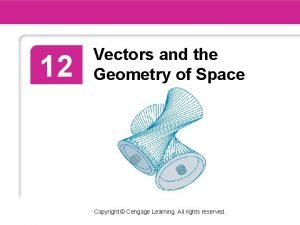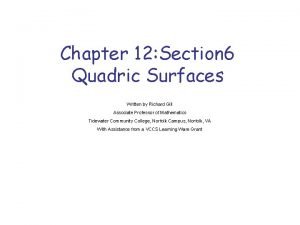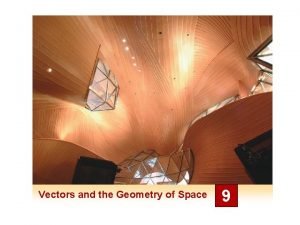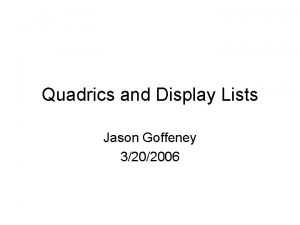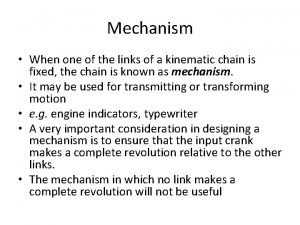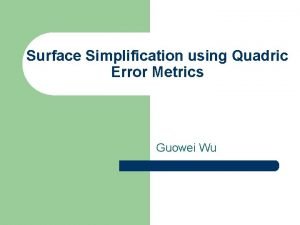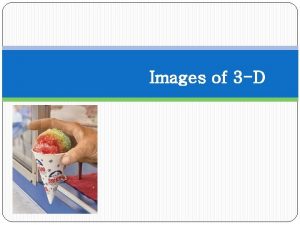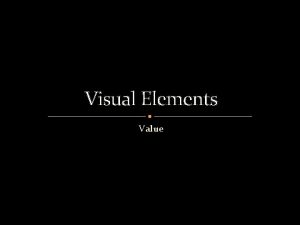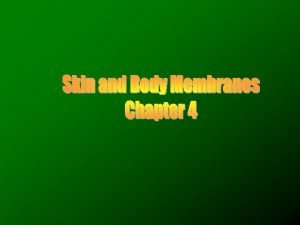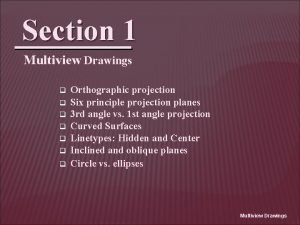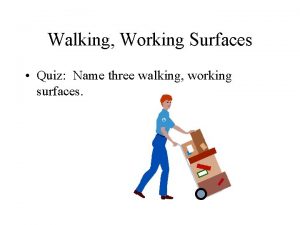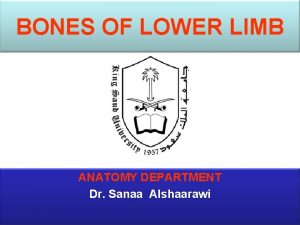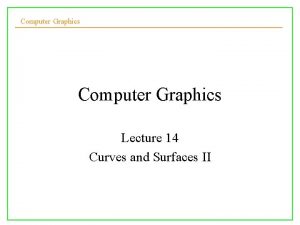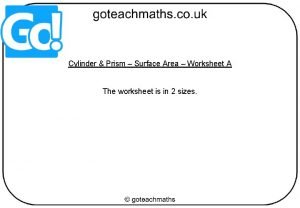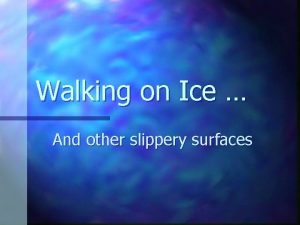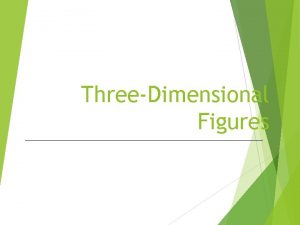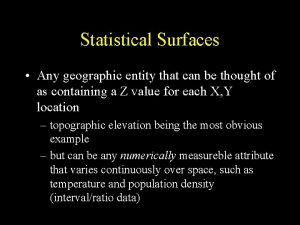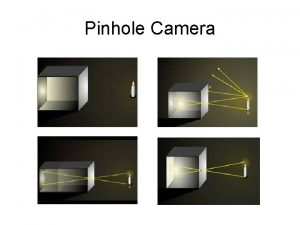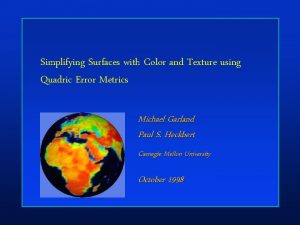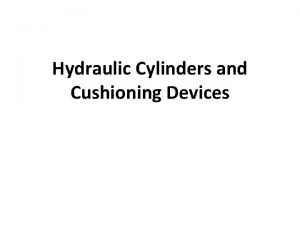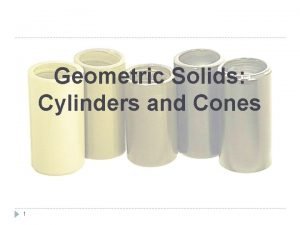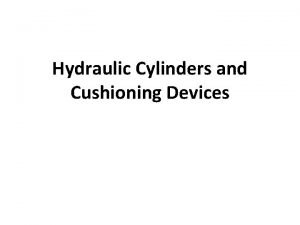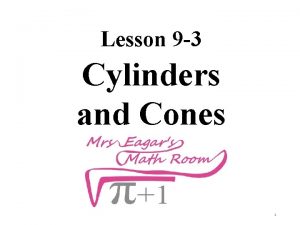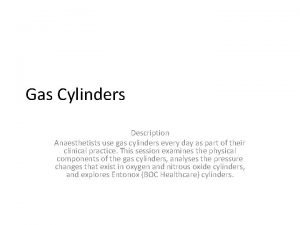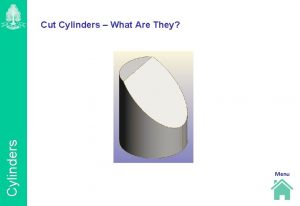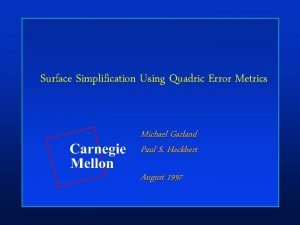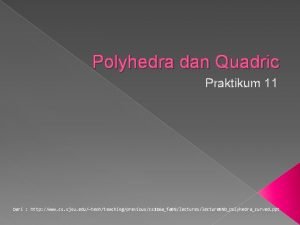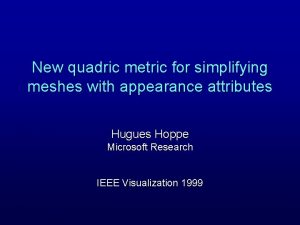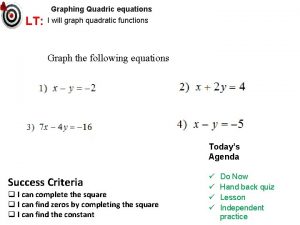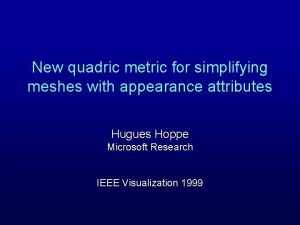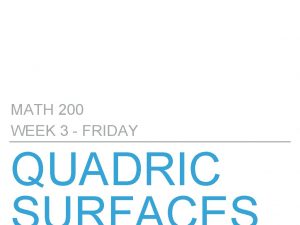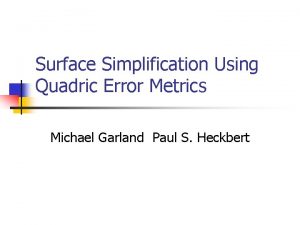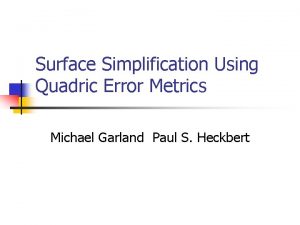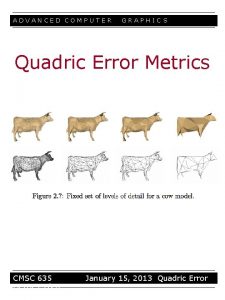12 6 Cylinders and Quadric Surfaces Cylinders and






















- Slides: 22

12. 6 Cylinders and Quadric Surfaces

Cylinders and Quadric Surfaces We have already looked at two special types of surfaces: planes and spheres. Here we investigate two other types of surfaces: cylinders and quadric surfaces. In order to sketch the graph of a surface, it is useful to determine the curves of intersection of the surface with planes parallel to the coordinate planes. These curves are called traces (or cross-sections) of the surface. 2

Cylinders A cylinder is a surface that consists of all lines, called rulings, that are parallel to a given line and pass through a given plane curve. If one of the variables x, y or z is missing from the equation of a surface, then the surface is a cylinder. 3

Example 1 Sketch the graph of the surface z = x 2. Solution: Notice that the equation of the graph, z = x 2, doesn’t involve y. This means that any vertical plane with equation y = k (parallel to the xz-plane) intersects the graph in a curve with equation z = x 2. So these vertical traces are parabolas. 4

Example 1 – Solution cont’d The graph is formed by taking the parabola z = x 2 in the xz -plane and moving it in the direction of the y-axis. This is called a parabolic cylinder, made up of infinitely many shifted copies of the same parabola. Here the rulings of the cylinder are parallel to the y-axis. 5

When you are dealing with surfaces in 3 D, it is important to recognize that an equation like x 2 + y 2 = 1 in 3 D represents a cylinder and not a circle! The trace of the cylinder x 2 + y 2 = 1 in the xy-plane is the circle with equations: x 2 + y 2 = 1, z = 0. 6

Quadric Surfaces By translation and rotation this can be brought into one of the two standard forms: Ax 2 + By 2 + Cz 2 + J = 0 or Ax 2 + By 2 + Iz = 0 Quadric surfaces are the counterparts in three dimensions of the conic sections in the plane. 7

Example 2 Use traces to sketch the quadric surface with equation Solution: By substituting z = 0, we find that the trace in the xy-plane is x 2 + y 2/9 = 1, which we recognize as an equation of an ellipse. • More generally, the horizontal trace in the plane z = k is which is an ellipse, provided that k 2 < 4, that is, – 2 < k < 2. 8

Example 2 – Solution cont’d Similarly, the vertical traces are also ellipses: • (if – 1 < k < 1) • (if – 3 < k < 3) So all traces are ellipses! Graph the full equation using various 3 D programs: http: //www. wolframalpha. com/ : plot[x^2+(y^2)/9+(z^2)/4=1] https: //geogebra. org/3 d: (just type in the formula) 9

Example 2 – Solution cont’d Graph: The ellipsoid It’s called an ellipsoid because all of its traces are ellipses. Notice that it is symmetric with respect to each coordinate plane; this is a reflection of the fact that its equation involves only even powers of x, y, and z. 10

Example 3 Use traces to sketch the surface z = 4 x 2 + y 2. Solution: • If we put x = 0, we get z = y 2, so the yz-plane intersects the surface in a parabola. If we put x = k (a constant), we get z = y 2 + 4 k 2. This means that if we slice the graph with any plane parallel to the yzplane, we obtain a parabola that opens upward. • Similarly, if y = k, the trace is z = 4 x 2 + k 2, which is again a parabola that opens upward. 11

Example 3 – Solution cont’d • If we put z = k, we get the horizontal traces 4 x 2 + y 2 = k, which we recognize as a family of ellipses. Knowing the shapes of the traces, we can sketch the graph: The surface z = 4 x 2 + y 2 is an elliptic paraboloid. Horizontal traces are ellipses; vertical traces are parabolas. 12

Example 4 Sketch the surface z = y 2 – x 2. Solution: • The traces in the vertical planes x = k are the parabolas z = y 2 – k 2, which open upward. • The traces in y = k are the parabolas z = –x 2 + k 2, which open downward. • The horizontal traces are y 2 – x 2 = k, a family of hyperbolas. Traces in x = k are z = y 2 – k 2 Traces in y = k are z = –x 2 + k 2 Traces in z = k are y 2 – x 2 = k 13

Example 4 – Solution cont’d If we fit together the traces from the previous graphs we get the surface z = y 2 – x 2, a hyperbolic paraboloid: Notice that the shape of the surface near the origin resembles that of a saddle. 14

Example 5 Sketch the surface: Solution: • The trace in any horizontal plane z = k is the ellipse z=k • but the traces in the xz- and yz-planes are the hyperbolas y=0 and x=0 15

Example 5 – Solution cont’d This surface is called a hyperboloid of one sheet and is sketched here: There also hyperboloids of two sheets. 16

Quadric Surfaces: Summary All these surfaces are symmetric with respect to the zaxis. If a quadric surface is symmetric about a different axis, its equation changes accordingly. Graphs of quadric surfaces 17

Applications of Quadric Surfaces 18

Applications of Quadric Surfaces Examples of quadric surfaces can be found in the world around us. In fact, the world itself is a good example. Although the earth is commonly modeled as a sphere, a more accurate model is an ellipsoid because the earth’s rotation has caused a flattening at the poles. World geodesic system (WGS 84) is the standard for GPS 19

Applications of Quadric Surfaces Circular paraboloids, obtained by rotating a parabola about its axis, are used to collect and reflect light, sound, and radio and television signals. In a radio telescope, for instance, signals from distant stars that strike the bowl are all reflected to the receiver at the focus and are therefore amplified. 20

Applications of Quadric Surfaces Cooling towers for nuclear reactors are usually designed in the shape of hyperboloids of one sheet for reasons of structural stability. 21

Applications of Quadric Surfaces Pairs of hyperboloids are used to transmit rotational motion between skew axes. https: //youtu. be/f. Gu. Lv. Vmkwb 0 22
 Quadric surfaces chart
Quadric surfaces chart Yz plane equation
Yz plane equation Quadratic surfaces
Quadratic surfaces Gluquadric
Gluquadric Watt's indicator mechanism
Watt's indicator mechanism Surface simplification using quadric error metrics
Surface simplification using quadric error metrics Three dimentional figure
Three dimentional figure 3d shapes with 6 faces 8 vertices 12 edges
3d shapes with 6 faces 8 vertices 12 edges The relative lightness and darkness of surfaces.
The relative lightness and darkness of surfaces. What are the three main types of body membranes
What are the three main types of body membranes Normal inclined and oblique surfaces
Normal inclined and oblique surfaces Vertical
Vertical Aircraft control surfaces and components
Aircraft control surfaces and components Walking and working surfaces quiz
Walking and working surfaces quiz Borders of femur
Borders of femur Curves and surfaces for computer graphics
Curves and surfaces for computer graphics Surface area of cylinders and prisms worksheet
Surface area of cylinders and prisms worksheet Walking on slippery surfaces
Walking on slippery surfaces Square pyramid face
Square pyramid face Subdivision surfaces in character animation
Subdivision surfaces in character animation Statistical surfaces can be
Statistical surfaces can be Reflection
Reflection Border of heart
Border of heart
